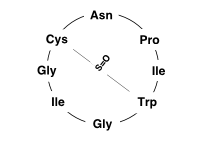Alpha-amantin
Alpha-amanitin is a potent and deadly toxin found in several species of the mushroom genus Amanita, most notably the Death Cap (Amanita phalloides) and the Destroying Angels (Amanita virosa and Amanita bisporigera). It is one of the most toxic known mushroom toxins and is a member of the amatoxins, which are bicyclic octapeptides.
Structure and Mechanism of Action[edit | edit source]
Alpha-amanitin is characterized by its unique bicyclic structure consisting of a hydroxylated tryptophan linked to a bicyclic octapeptide. This structure is crucial for its interaction with RNA polymerase II, a key enzyme in the synthesis of messenger RNA (mRNA) in eukaryotic cells. By binding strongly to the enzyme, alpha-amanitin effectively blocks the transcription process, leading to cell death. This mechanism of action highlights the toxin's potency, as it interferes with a fundamental cellular process.
Toxicity and Symptoms[edit | edit source]
The toxicity of alpha-amanitin is profound, with an oral LD50 (lethal dose for 50% of individuals) in the range of 0.1 mg/kg for humans. This makes even a small ingestion of material containing the toxin potentially lethal. Symptoms of poisoning typically begin with a latency period of 6 to 12 hours after ingestion, starting with severe gastrointestinal distress, including vomiting, diarrhea, and abdominal pain. These initial symptoms can subside, giving a false impression of recovery; however, they are followed by a more severe phase characterized by liver and kidney failure, and without prompt and appropriate treatment, death can occur within 7 to 10 days due to multi-organ failure.
Treatment[edit | edit source]
There is no specific antidote for alpha-amanitin poisoning. Treatment is primarily supportive and aims to reduce the toxin's absorption and support the affected organs. This can include the use of activated charcoal, aggressive hydration to prevent kidney damage, and the administration of penicillin G and silymarin, which have been suggested to have some protective effects on the liver. In severe cases, liver transplantation may be considered as a last resort.
Epidemiology[edit | edit source]
Alpha-amanitin poisoning is a significant cause of fatal mushroom poisonings worldwide, primarily due to the ingestion of Amanita phalloides. The mushrooms containing this toxin are found in various parts of the world and can be mistaken for edible species, leading to accidental ingestion. Public education on the identification of mushrooms and the risks associated with foraging wild species is crucial in preventing poisonings.
Prevention[edit | edit source]
Prevention of alpha-amanitin poisoning is primarily through education and awareness. Mushroom foragers should follow the adage, "When in doubt, throw it out," to avoid the risk of consuming toxic species. Additionally, the use of expert resources, such as local mycological societies, can aid in the safe identification of edible mushrooms.
Search WikiMD
Ad.Tired of being Overweight? Try W8MD's physician weight loss program.
Semaglutide (Ozempic / Wegovy and Tirzepatide (Mounjaro / Zepbound) available.
Advertise on WikiMD
|
WikiMD's Wellness Encyclopedia |
| Let Food Be Thy Medicine Medicine Thy Food - Hippocrates |
Translate this page: - East Asian
中文,
日本,
한국어,
South Asian
हिन्दी,
தமிழ்,
తెలుగు,
Urdu,
ಕನ್ನಡ,
Southeast Asian
Indonesian,
Vietnamese,
Thai,
မြန်မာဘာသာ,
বাংলা
European
español,
Deutsch,
français,
Greek,
português do Brasil,
polski,
română,
русский,
Nederlands,
norsk,
svenska,
suomi,
Italian
Middle Eastern & African
عربى,
Turkish,
Persian,
Hebrew,
Afrikaans,
isiZulu,
Kiswahili,
Other
Bulgarian,
Hungarian,
Czech,
Swedish,
മലയാളം,
मराठी,
ਪੰਜਾਬੀ,
ગુજરાતી,
Portuguese,
Ukrainian
Medical Disclaimer: WikiMD is not a substitute for professional medical advice. The information on WikiMD is provided as an information resource only, may be incorrect, outdated or misleading, and is not to be used or relied on for any diagnostic or treatment purposes. Please consult your health care provider before making any healthcare decisions or for guidance about a specific medical condition. WikiMD expressly disclaims responsibility, and shall have no liability, for any damages, loss, injury, or liability whatsoever suffered as a result of your reliance on the information contained in this site. By visiting this site you agree to the foregoing terms and conditions, which may from time to time be changed or supplemented by WikiMD. If you do not agree to the foregoing terms and conditions, you should not enter or use this site. See full disclaimer.
Credits:Most images are courtesy of Wikimedia commons, and templates Wikipedia, licensed under CC BY SA or similar.
Contributors: Prab R. Tumpati, MD

